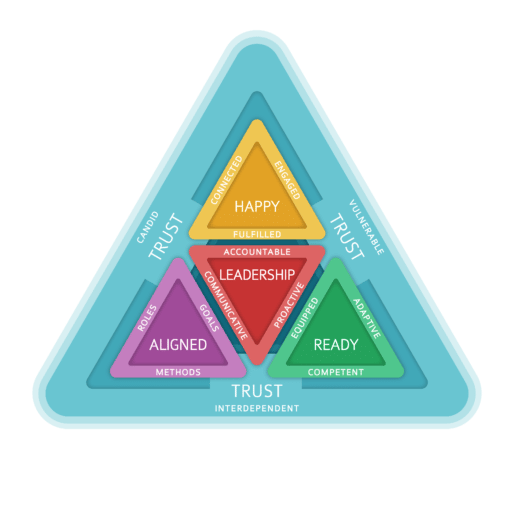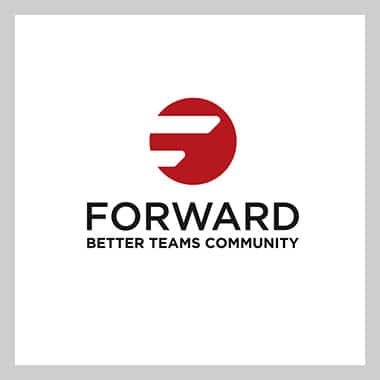Ways to Set Your Team Up for Success in 2022
As we move into 2022, you may be asking yourself how you can most effectively set your team up for success with all the uncertainty that persists in the workplace due to COVID, staffing challenges, and pressure to perform. It’s clear that teams will face continued stressors and challenges as we move into 2022. That’s why it’s more critical now than ever before to put focus and effort into our team dynamics and ways of working – so you can retain talent and build happy, high-performing teams.
At Better Teams, we rely on the Better Teams model – which has broad applicability for teams of every size, across industries, and in a multitude of scenarios – to guide our work with companies worldwide. By using our Better Teams Model as a framework, the following five fundamental activities are sure to set your team up for success in 2022 and beyond.

1. Encourage a LEADERSHIP mindset.
One example of embodying a leadership mindset is taking proactive action. Discuss the trends and changes in your industry or with your stakeholders and with your team. Then, take your team through collaborative strategy sessions designed to maximize the next year (or longer). Ask, what can you do to get ahead of the challenges you or your clients are facing? How can you adjust or adapt to new needs? What can you reduce or eliminate to free up your resources?
Actions:
Develop, document, and communicate the trends, challenges, and opportunities your team (and your clients) will experience this year. Use this to inform your team’s annual goals. Feel free to use this team activity for future planning.
2. Get ALIGNED about why, what, and how.
When change is consistent, it is critical that teams re-align regularly. Slowing down to re-align periodically will speed up your team’s success. Be sure everyone on the team is clear and onboard with the team vision and goals, roles and responsibilities of each team member, and how your team will work together. If there is confusion or misunderstandings about the what, the who, or the how your team will have greater conflict and frustration.
Actions: Set up a team meeting early in the year to review the vision/goals, team roles, and responsibilities, and confirm how the team wants to work and meet together. Consider using the Best Teams exercise for developing your Team Norms.
3. Ensure the team is READY to succeed.
One characteristic of a better team is the ability to be adaptive. Yet, with so much uncertainty, many people are fatigued and overwhelmed. Check-in with each team member to find out how ready they are. Do they feel equipped? Do they have the knowledge or training needed to be successful? How high is their stress level and where (if at all) do they need additional support?
Actions:
Meet individually with each team member to assess their current level of readiness. Identify what each colleague needs and how you can support them in their role. Use the following questions to assess personal development goals and needs.
4. Cultivate a HAPPY team environment.
We are experiencing “The Great Resignation” because so many people are unhappy and unfulfilled in their jobs. In a world where many people now work remotely, it takes more effort to connect and build meaningful relationships. It’s easier to leave a job or company if you have no personal connections. Additionally, more people are stating they want to do work that is meaningful. Helping your team identify the significant impact they are making is an important component of retaining talent.
Actions:
Meet at least once a week as a team and specifically build in time for personal connections. Facilitate simple team building activities at the beginning of your meeting to build relationships. Check with your team to find out how happy they are and what they need to be fulfilled and engaged with their work. Listen to their requests and work to honor them.
These three ways to connect with your team in 15 minutes or less work really well!.
5. Build and nurture TRUST.
Trust is the glue that binds a team together. When teams trust each other, they can give and receive direct and useful feedback. This skill requires reinforcement because most people perceive this as risky. First, the team must agree that they want to be candid with each other about needs, expectations, and requests. Then, the team needs to build the skills required to deliver requests constructively. Learning to listen deeply is a fundamental skill that supports this communication process and builds trust. To get personalized listening or feedback training, please reach out to Better Teams.
Actions: Begin by asking for feedback about your own performance. Then, demonstrate an openness to listen to understand it and willingness to make modifications to improve it. If you model this consistently as a leader, you will create a culture that normalizes candid conversations.
Conclusion
As you think about these five actions and your team, determine where you believe you will be able to make the greatest strides and deliver a return on your investment of time. Don’t forget to ask your team for their input and collectively decide about which areas need the most focus.
Taking time to think proactively, re-align, check-in, connect and build trust will pay off in dividends. Happy and high-performing teams require attention and on-going effort.
The Better Teams Model & Assessment is an excellent resource to gather your team’s input about these five core areas – Leadership, Alignment, Readiness, Happiness, and Trust.
Would you like support to solidify your team for 2022? Just reach out to Better Teams, we have a variety of resources, tools, courses, assessments, and facilitators ready to help you.
About the Author: Leigh Ann Rodgers, Founder of Better Teams and the Forward, community, is an IAF Certified Professional Facilitator with 20 years of experience in the human development field. Leigh Ann is a skilled meeting facilitator, trainer, and coach working across the globe to help leaders cultivate teams that are happy and high-performing.
Learn. Share. Practice. Move FORWARD. Join the Better Teams community, FORWARD, to network and grow with some of the most experienced professionals in the field of team building and facilitation. LEARN MORE

